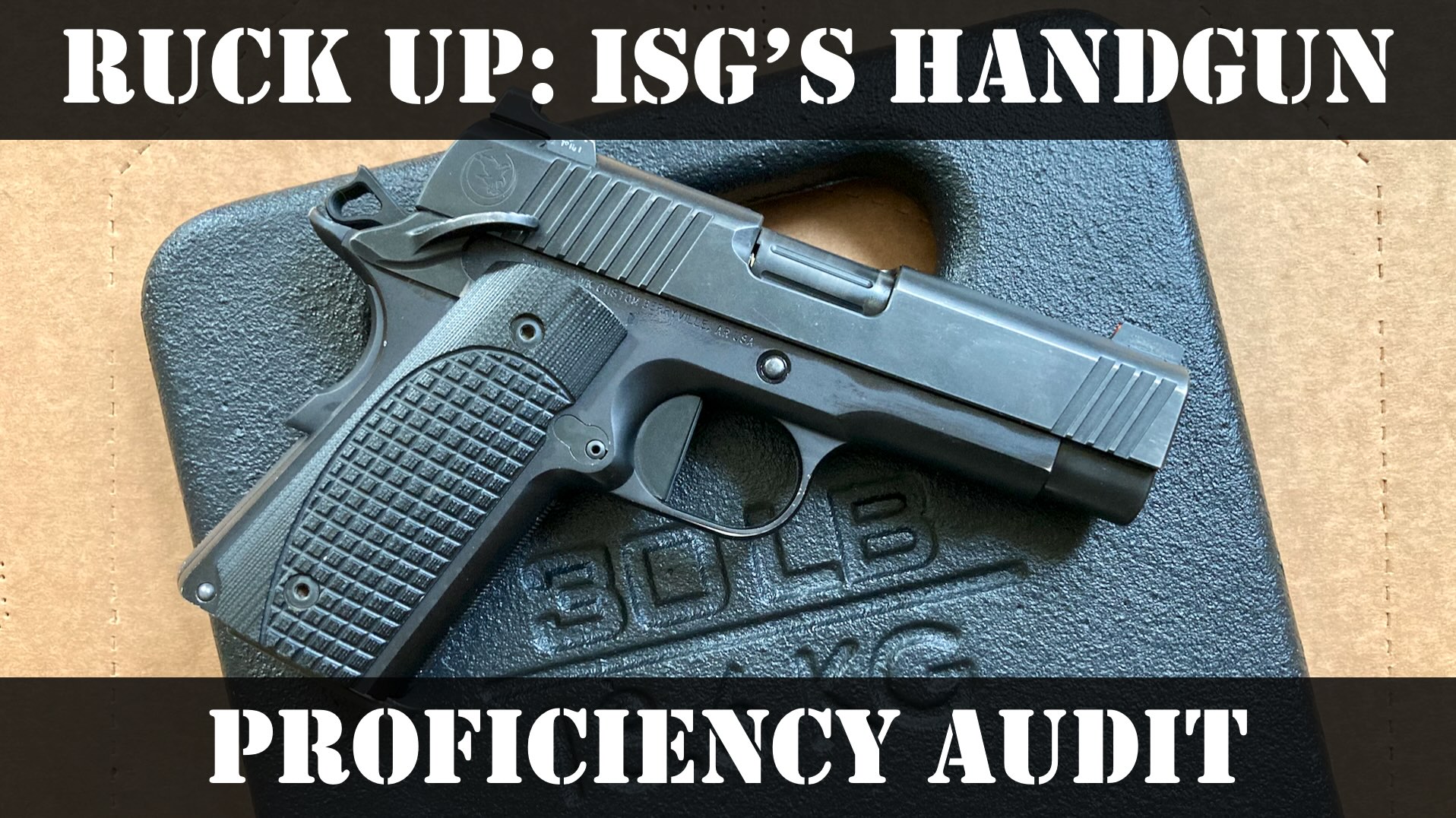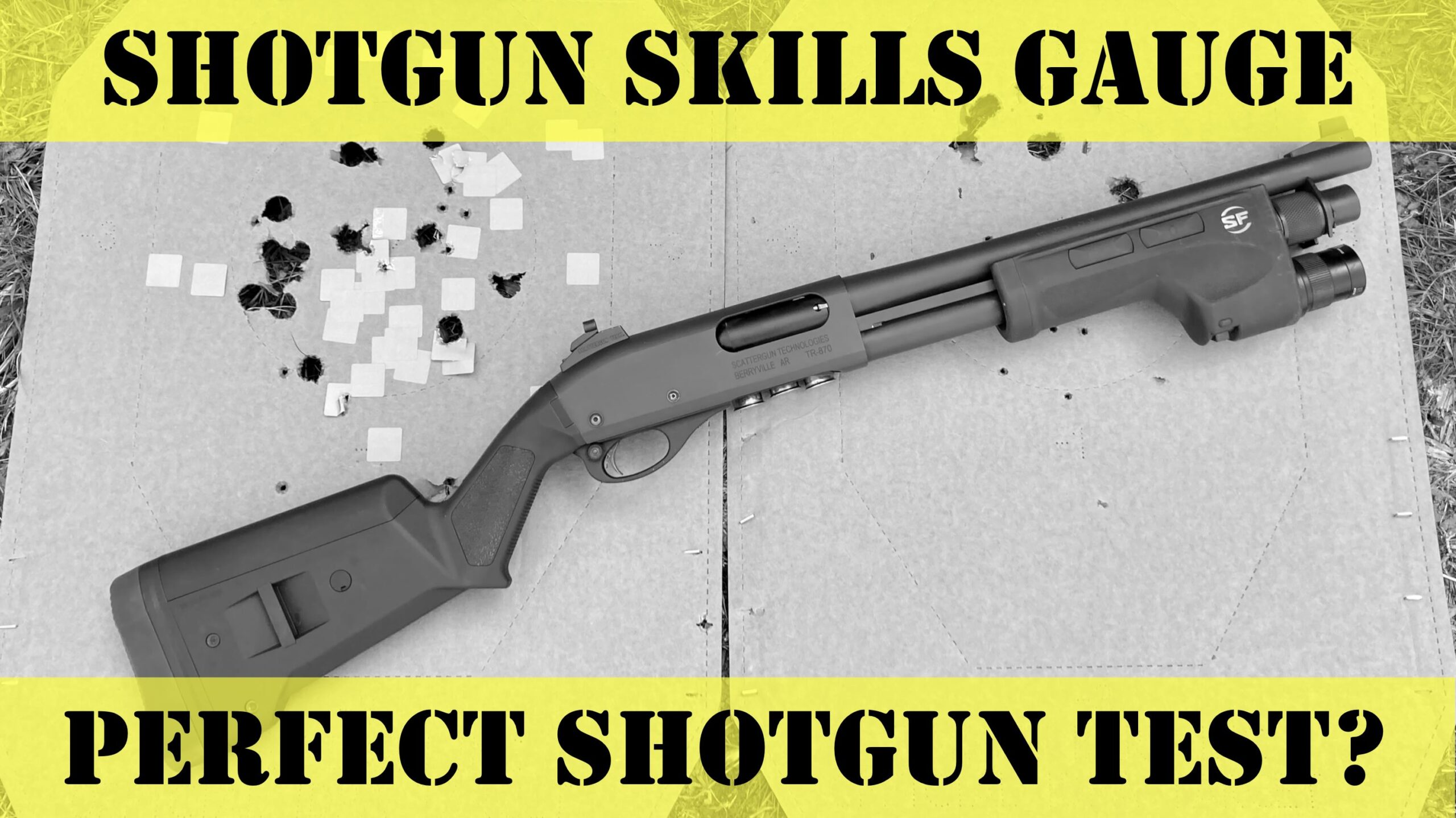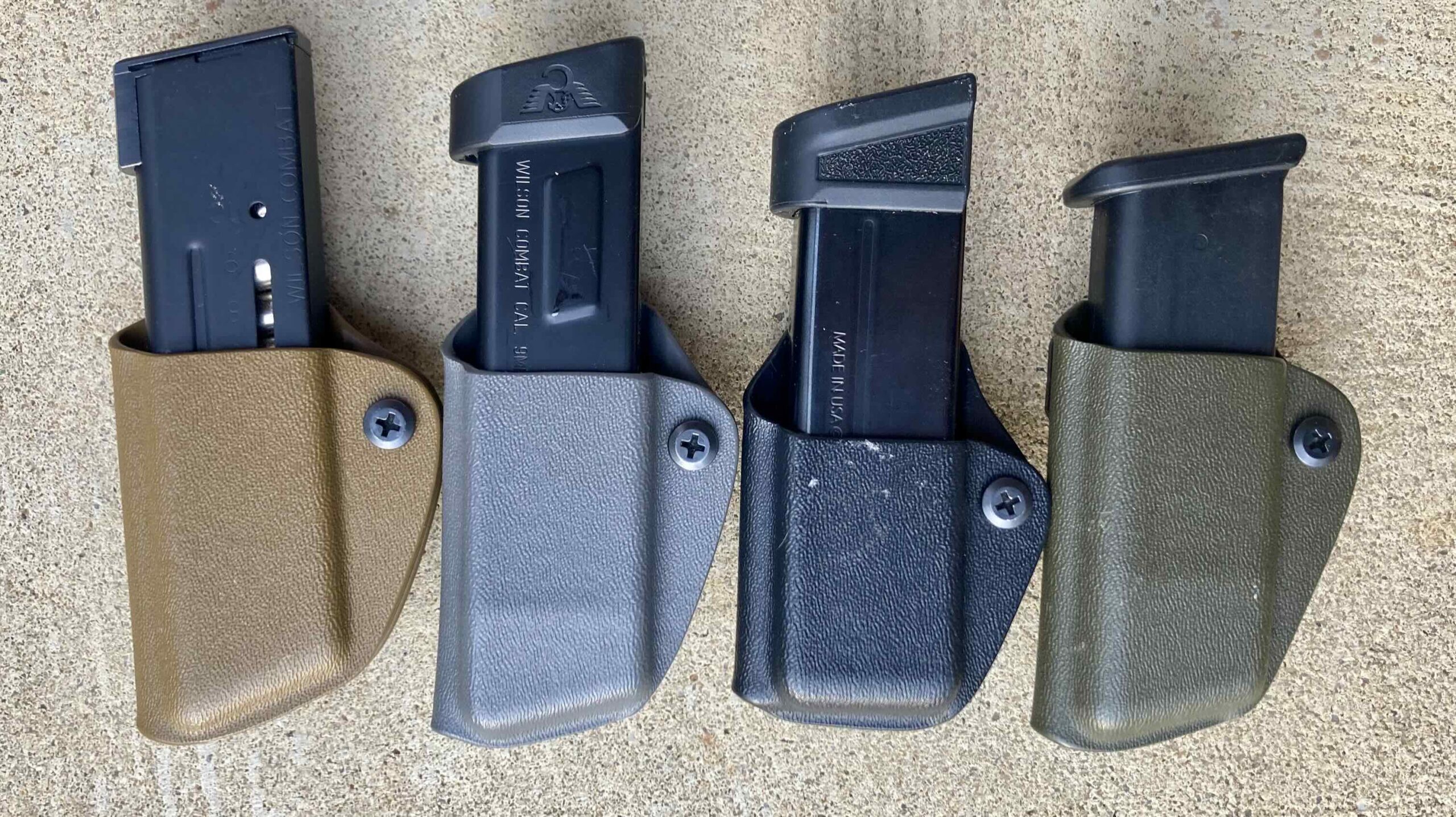I hate to admit this, but despite a lifetime of being a shooter and firearms enthusiast, I only put together my first range bag about two years ago. Honestly, it changed my life. I cannot imagine not having a range bag now. I know there are a whole lot of new shooters finding their way into the sport, so I though this might be a good time to talk about setting up a range bag.
This article contains affiliate links
I admit that I used to think a range bag was unnecessary. “I have all sorts of bags and I can get all my stuff to and from the range – why do I need a special bag for that?” In fact, I kind of liked being the guy that showed up with all his crap in a Wal-Mart bag…then could out-shoot basically anyone there. But it turns out I just didn’t know what I was missing. I finally have a range bag and I’ll never go back.
Why a Range Bag?
When it’s time to go to the range, whether a planned outing or a spur-of-the-moment time-killer, you already have most of your stuff packed and ready. You don’t have to reinvent the wheel because most of your common stuff is already setup and waiting. I’ll talk more about what that “stuff” is a little later on. You probably just have to throw in the guns you’re taking and some ammo and you’re good to go. This ends up saving a lot of time. As a guy that hasn’t used a range bag for most his life you can take my word on that – a range bag is a game-changer.
Having a pre-packed range bag prevents you from forgetting stuff. Need a little screwdriver to adjust those sights? How about a shot of lube, or a multitool? Need a marker to mark something on that target? What about hearing protection and eye protection? All of that stuff is readily available in your range bag – not scattered all over your garage.
Not only does a range bag prevent completely forgetting something – it makes range trips more efficient. Range time is expensive. I try to maximize it by dry practicing at home, loading magazines at home, etc. Basically, I do everything I can at home so when I get to the range I can spend my pay-by-the-hour time doing the one thing I can’t do at home: shooting.
Finally and maybe most importantly, you don’t risk ammunition, brass, firearms parts, etc. in a bag you use for day-to-day life stuff. As mentioned in the outstanding travel guide Choose Adventure, you shouldn’t put ammunition in the bags you travel with – the risk of arrest for having a live round is simply too great. The same goes for those of you that work in courthouses, federal buildings, or other restrictive locations – don’t use your laptop bag for range trips.
Anecdotally I had a co-worker who accidentally “tried” to bring a loaded 1911 into a federal building in Washington, D.C. He had forgotten it was in his laptop bag. He got out of the situation…but paid an attorney almost $10,000. A range bag easily lets you designate a bag that gets loaded with guns and ammo, and allows you to protect your other bags and packs.
The Bag Itself
There are a few factors that make a decent range bag. It should be large enough to carry most of your stuff, rigid enough not to fold up under the weight of a couple boxes of ammo, and rugged enough to survive trip after trip to the range. Beyond that there are a few things you should look for.
A range bag should protect your handguns. I really like having padded slots to slide handguns into. This keeps them from banging into other guns, boxes of ammo, etc. I rarely take more than three handguns to the range (one on my body, and one on each side of my range bag) but occasionally I do. For those occasions I keep an old, rubber mouse pad in my range bag. I can wrap one gun in the mouse pad and it can share a slot with another.
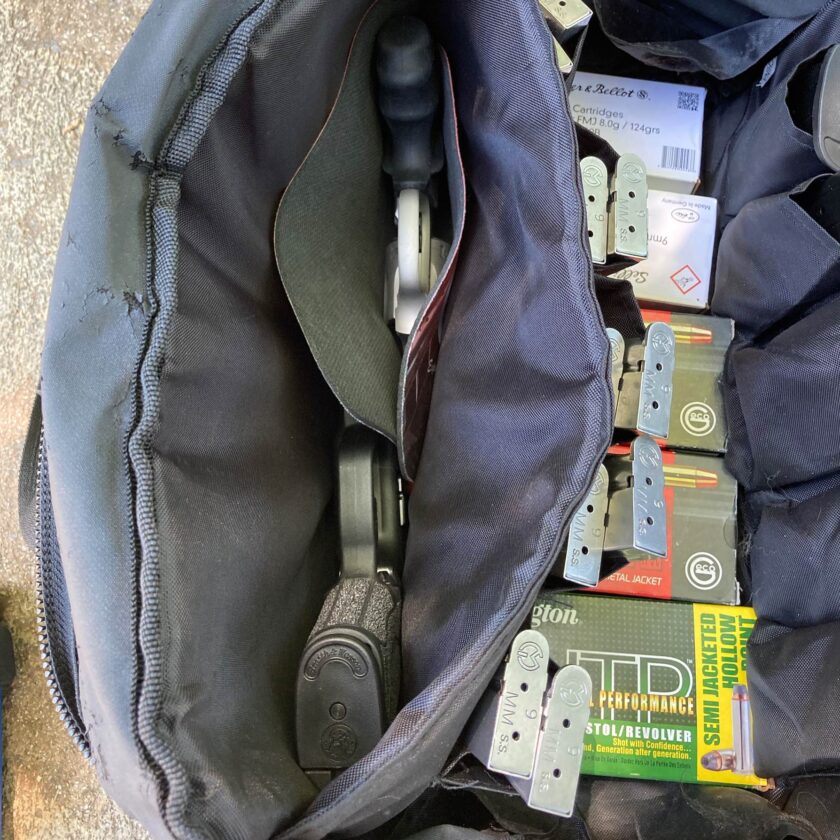
A range bag should offer decent organization without being cluttered. I really, really like the bag I have now. It gives me slots for magazines, a smaller, and zippered front pocket with a couple pouches. The handgun slots hold handguns, and the large center pocket is perfect for lining up boxes of ammo. There is a protective pouch for my safety glasses, and a slot that holds my multi-tool and pens. Much more than that would be overkill for my typical range trip. I can easily load up two pistols and 400 rounds of ammo, plus all my support stuff. What more do you need?
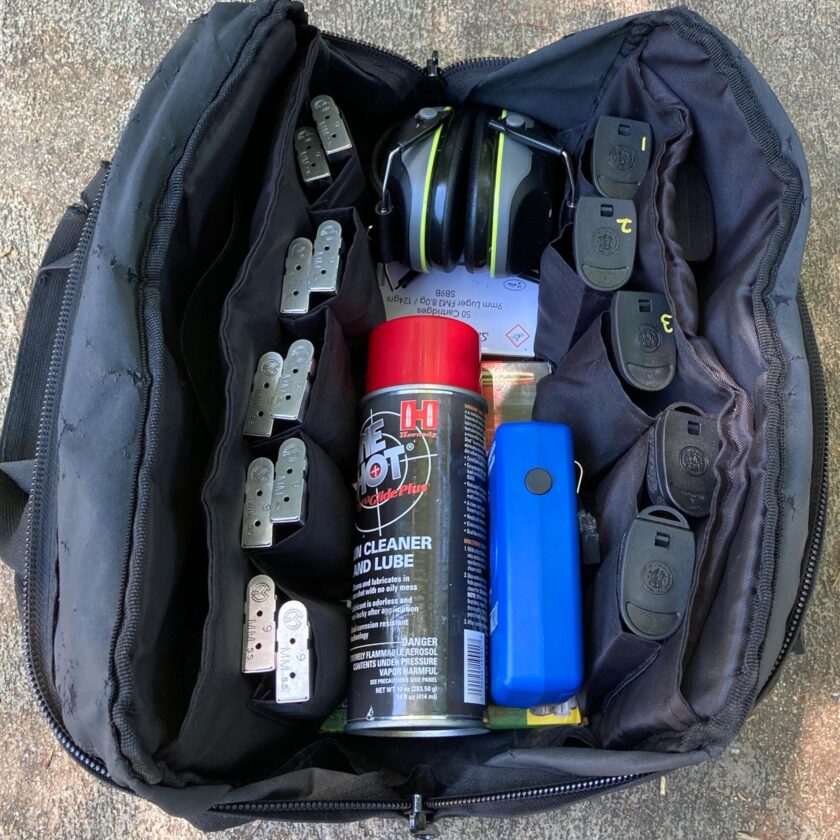
So what range bag do I use? The range bag I use is the Wilson Combat “Deluxe Range Bag, Large.” It was given to me as a gift by my friend Rich Brown of the excellent American Warrior Show. Unfortunately I can’t really recommend another range bag because I just don’t have that much experience with range bags.
So what do I keep in the range bag that magically changed my life?
Range Bag Stuff: Eye & Ear Protection
I am very serious about hearing protection. I have lost a major portion of my hearing and trust me – it’s not something you want to happen to you. It sometimes causes conflict in my relationship, makes me look either dumb or disinterested in noisy settings, and lowers my situational awareness. I was given hearing aids in my late 20s. Failing to protect your ears is tantamount to intentionally handicapping yourself; if you expose yourself to loud noises without hearing protection you WILL – no ifs, ands or buts, no matter how much you can deadlift, how many tattoos you have, or how tall your truck is, I repeat you WILL – lose hearing. That’s not tough, it’s stupid.
I take great pains to protect the hearing I have left. I use both ear plugs and ear muffs when shooting anything larger than a .22 LR (I still use one or the other when shooting .22s, just for the record), and always use both when shooting indoors. Muffs stay in my range bag, along with a baggie of ear plugs. Ten or 15 spare pairs of plugs will last me a year or two, and gives me plenty of extras to loan out to friends if they need them.
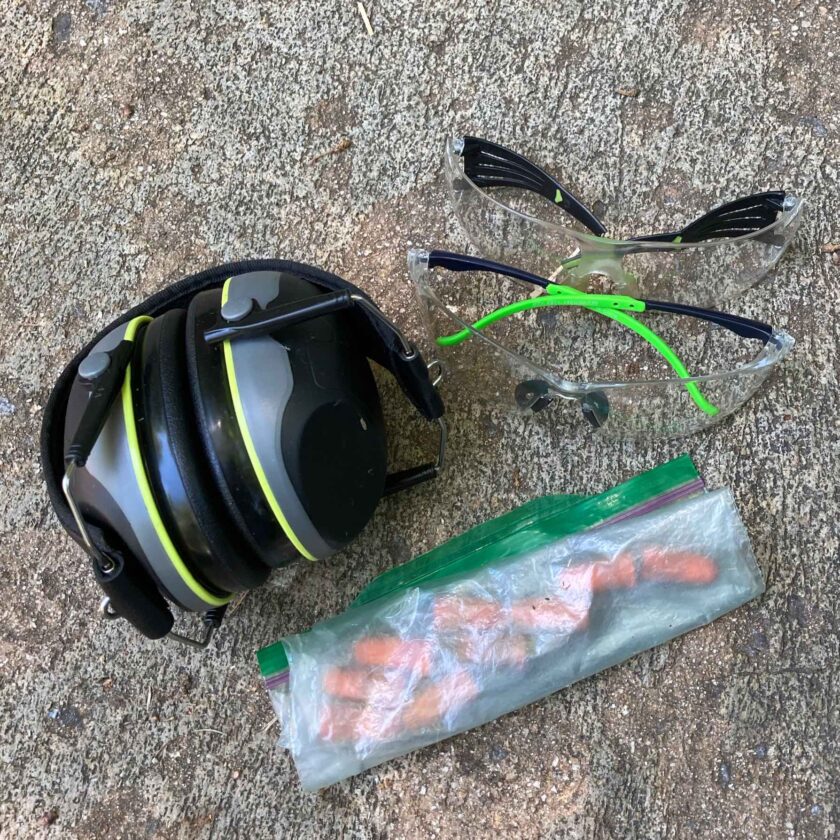
I know a lot of people like electronic muffs. I don’t – they don’t really help me much, and are actually kind of frustrating. Also, most of them offer less noise attenuation than passive muffs. They seem to work really well for most people, though. If you like them, Peltor is probably the de facto brand.
I also keep two pairs of clear, z87-rated safety glasses in my range bag. Unlike hearing loss, eye damage is acute rather than chronic. It can happen in an instant and all at once. I keep a pair for myself and an extra…in case I forget, lose or break a pair, or need to loan one out to someone else. They aren’t cool but my safety glasses aren’t a fashion statement. I don’t keep interchangeable lens, multi-hundred-dollar Oakleys in my range bag, just decent, dedicated-purpose, clear-lens glasses that protect my eyeballs and that I’m not afraid to trash when they get scratched.
Range Bag Stuff: Tools & Cleaning Gear
There are just a few tools that I keep in my range bag. One is a Gerber multi-tool, and one is a multi-bit screwdriver. The multi-tool works for a lot of different things. One thing it doesn’t do very well is turn very small screws. I bought this very simple, interchangeable-bit screwdriver expressly for my range bag. As a frequent revolver shooter I frequently need to adjust sights, and this is just about perfect. It has an array of small screwdrivers tips that work well when adjusting sights or tightening other small, gun-specific screws.
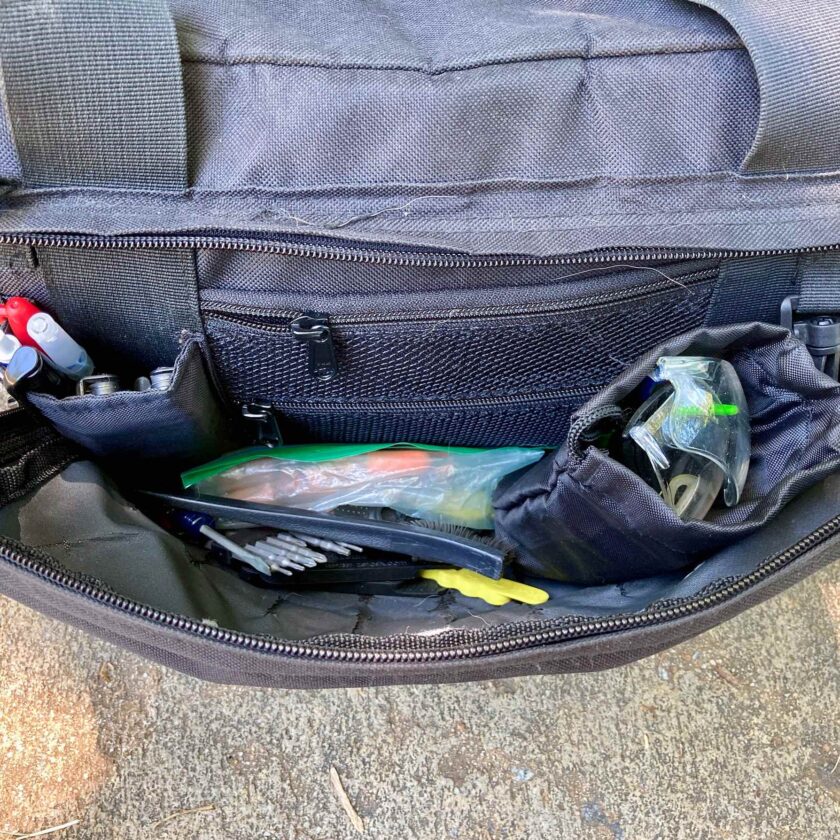
I also keep just a bit of cleaning gear in my range bag. This consists of an AP brush and some lube. I don’t carry around much more than that because I’ll do my cleaning at home. A little lube and/or knocking off some grit here and there can work wonders so I make sure to keep those items on hand.
Range Bag Stuff: Shooting Stuff
Finally we get to the actual shooting stuff. Obviously I want ammunition to go in my range bag. I really, really like my bag as it allows boxes of ammo to sit horizontally across the bottom of the bag. The boxes of ammo provide a good platform for larger items like lube and my shot timer. In the pics here I have 250 rounds of ammo. That’s enough for a really good range session if you’ve planned ahead, prepared some drills, and set some priorities.
I also really like the magazine organization in this range bag. it holds 20 single-stack mags or 10 double-stack mags (and you could probably cram in a few more). I don’t usually have it loaded up with this many magazines, but having the option is really nice. Let’s look at what else is in here.
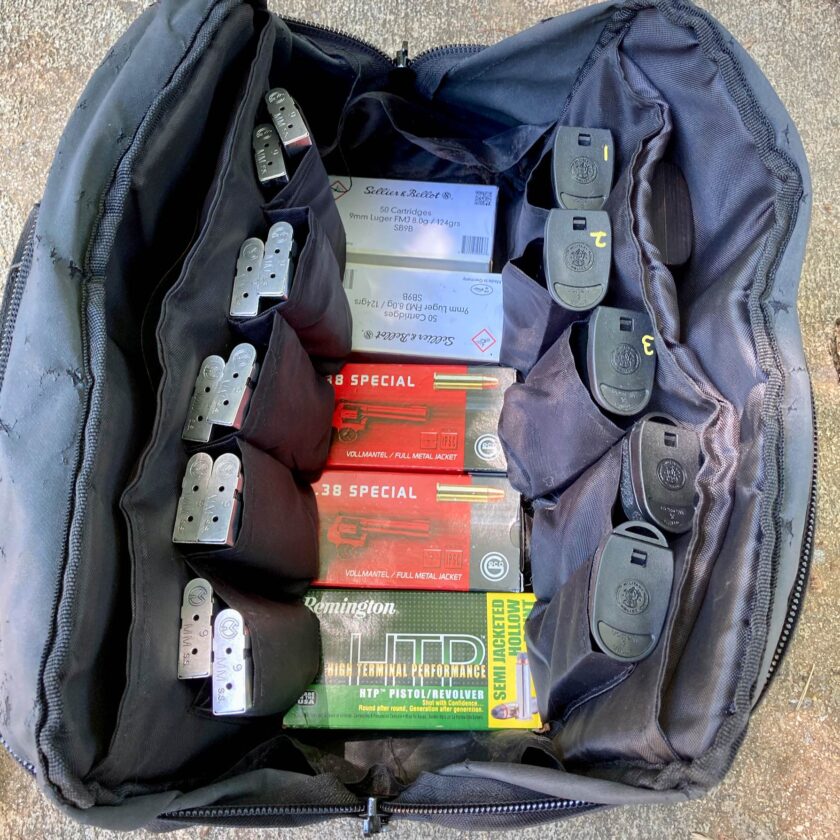
Shot Timer: I take my Competition Electronics Pocket Pro II shot timer to the range absolutely 100% of the time. I might not use it during the occasional session, but I always have it. It constantly amazes me the number of “shooters” who don’t own or use a shot timer. I get it – the idea that you might find out you suck is intimidating. Guess what? If you aren’t checking yourself against the clock you probably do. It doesn’t matter how many certificates are on your wall or how great you were in that class eighteen months ago; if you aren’t at least quantifiably maintaining that skill, it’s degrading.
Targets and Target Stuff: When I pulled my range bag out to take these photos there weren’t any targets in there. That’s because my new home range requires shooting on targets purchased there. I occasionally fudge and shoot a Dot Torture or something, but usually try to support them (range owners take note: I would probably be at the range much more if it weren’t for this rule. Is the couple bucks generated through target sales worth alienating your best clientele?). Normally though, my range bag has an assortment of print-at-home targets including Dot Torture, the 5×5 Drill (not the Wilson 5×5 Skills Test, which is shot on an IDPA silhouette), the 1-2-R-3, etc.
Aside from targets themselves, I normally keep some things to mark and hang targets. I always have a Sharpie or two, and a pen or two. This lets me mark shots before firing a new drill. I tried to keeping a roll of pasters in my range bag, but a bottle of CLP spilled on it, ruining it and I haven’t replaced it. Ditto for a roll of masking take. I will replace the masking tape soon and probably forget about the shot pasters; masking tape is more multi-use: it can cover shot holes as well as hang targets.
Admin Stuff
Finally I keep a few admin supplies. These probably won’t impact your shooting experience much, but:
Pens & Paper: I do keep some pens and a notebook in my range bag. I use it to jot down drills before I leave home, and to record results at the range.
Business Cards: Finally, I keep a couple business cards in my bag. It is rare but I have run across people at the range with whom I’d like to stay in touch. More frequently I have needed to give a card to someone working at the shop where I am transferring a firearm. I don’t need them frequently, but it is nice to have one when you do need it.
Closing Thoughts
And that’s pretty much it. There is certainly more stuff you can put in a range bag but I would strive to avoid clutter – that delicate balance between having enough stuff without having too much. Hopefully, if you don’t have a range bag this motivates you to put one together. And if you do, this might motivate you to take a look at what’s in it. A well-organized range bag will change your shooting life!



